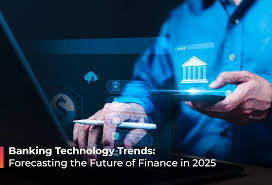The Future of Banking: Trends and Innovations Shaping the Financial Industry
Introduction
The banking industry is experiencing a profound transformation, driven by advancements in technology, regulatory changes, and evolving consumer expectations. From digital banking to fintech innovations, banks and financial institutions must adapt to the changing landscape to stay competitive and meet the needs of their customers. In this article, we’ll explore the key trends and innovations that are shaping the future of banking and what it means for both consumers and financial institutions.
1. The Rise of Digital and Online Banking
Traditional brick-and-mortar banks are rapidly being overshadowed by digital banking services. With the growing preference for convenience and the rise of mobile-first users, digital banking has become a significant driver of change in the industry.
- Mobile Banking: Consumers are increasingly relying on mobile apps to manage their finances, transfer money, and apply for loans. Banks are responding by offering user-friendly mobile platforms that allow customers to perform a variety of banking tasks from anywhere in the world.
- Neobanks and Digital-Only Banks: Neobanks are digital-only financial institutions that operate without physical branches. These banks offer low fees, high-yield savings accounts, and streamlined services, making them an attractive option for tech-savvy consumers.
- Online Banking Security: As digital banking becomes more widespread, security and fraud prevention are top priorities. Banks are investing in advanced cybersecurity measures, multi-factor authentication, and encryption technologies to protect customer data and ensure secure transactions.
2. The Growth of Fintech and Open Banking
Fintech (Financial Technology) has emerged as a major disruptor in the banking sector, offering innovative solutions that simplify and improve financial services. Alongside this, the concept of open banking is reshaping how financial institutions share data and collaborate with third-party providers.
- Fintech Solutions: Fintech companies are providing innovative alternatives to traditional banking services, including peer-to-peer lending, digital wallets, robo-advisors, and blockchain-based solutions. These services offer greater transparency, efficiency, and accessibility, particularly for underbanked or underserved populations.
- Open Banking: Open banking is the practice of sharing customer financial data securely with third-party applications through APIs (Application Programming Interfaces). This allows for a more integrated financial ecosystem where customers can access a wider range of financial products, such as budgeting tools, investment platforms, and credit scoring services, all from one central location.
- Blockchain and Cryptocurrencies: Blockchain technology and cryptocurrencies like Bitcoin and Ethereum are reshaping the financial landscape. Banks are exploring the potential of blockchain for secure transactions, cross-border payments, and reducing fraud. While cryptocurrencies are still volatile, their rise has led to increased interest in digital assets and decentralized finance (DeFi).
3. Artificial Intelligence and Machine Learning in Banking
Artificial intelligence (AI) and machine learning (ML) are becoming integral parts of the banking industry, driving efficiency, personalization, and security.
- AI-Powered Customer Service: Many banks are adopting AI-powered chatbots and virtual assistants to handle customer inquiries and provide 24/7 support. These tools can resolve common issues, assist with banking transactions, and even offer personalized financial advice based on customer behavior.
- Personalized Banking Experience: Machine learning algorithms analyze customer data to offer personalized financial products and services. Banks can now provide targeted offers, loan products, and investment advice based on an individual’s financial behavior, preferences, and goals.
- Fraud Prevention and Risk Management: AI and machine learning are also playing a key role in detecting fraudulent activity and managing financial risks. By analyzing transaction data in real-time, AI can flag suspicious behavior, helping banks prevent fraud before it happens.
4. Sustainability and Ethical Banking
As consumers become more conscious of environmental and social issues, sustainable banking practices are gaining momentum. Banks and financial institutions are increasingly incorporating sustainability into their operations, products, and services.
- Green Banking Products: Many banks are offering products that promote sustainable practices, such as green bonds, eco-friendly loans, and investments in renewable energy. Consumers can now choose to invest in companies that align with their values and help address climate change.
- ESG (Environmental, Social, and Governance) Investing: ESG investing is a growing trend in the financial sector, as investors seek to support companies that prioritize environmental protection, social justice, and good governance. Banks are responding by offering ESG investment funds, socially responsible mutual funds, and impact investing opportunities.
- Sustainable Business Practices: In addition to offering green financial products, banks are also working to reduce their own environmental impact by adopting paperless operations, utilizing renewable energy, and minimizing waste in their offices and branches.
5. Financial Inclusion and Access to Banking Services
One of the most significant challenges facing the banking industry is improving financial inclusion for underbanked and underserved populations. Many people around the world still lack access to basic banking services, which can hinder their ability to save, invest, or access credit.
- Mobile Banking for the Unbanked: Mobile phones are enabling individuals in remote or rural areas to access banking services without the need for a physical bank branch. Through mobile banking apps and digital wallets, consumers can perform basic financial transactions, transfer money, and even receive microloans.
- Microfinance and Peer-to-Peer Lending: Microfinance institutions and peer-to-peer lending platforms are helping individuals in developing regions access small loans and financial resources to start businesses or cover essential needs. These platforms are empowering people to take control of their financial futures.
- Financial Education: Many financial institutions are offering educational programs and resources to help individuals better understand personal finance, savings, investments, and credit. By promoting financial literacy, banks can help bridge the gap and enable more people to participate in the formal financial system.
6. The Future of Banking: What’s Next?
As technology continues to evolve, the future of banking will likely feature even more innovation, personalization, and digitalization. Several emerging trends and technologies could further shape the banking industry:
- Voice Banking: Voice assistants like Amazon Alexa and Google Assistant are being integrated into banking services, allowing customers to check their account balances, transfer funds, and make payments using voice commands.
- Quantum Computing: While still in its infancy, quantum computing holds the potential to revolutionize banking by solving complex financial problems and optimizing risk management and fraud detection algorithms.
- Digital Identity: The concept of digital identity will become increasingly important in the banking sector as financial institutions look to streamline onboarding processes and improve security. Blockchain technology could play a key role in enabling secure, verifiable digital identities.
Conclusion
The banking industry is undergoing rapid change, driven by advancements in technology, shifting consumer expectations, and a greater focus on sustainability and financial inclusion. As digital banking, fintech innovations, AI, and other trends continue to reshape the landscape, banks must remain adaptable and forward-thinking to stay competitive. The future of banking is undoubtedly digital, and those who embrace change and prioritize customer needs will be best positioned for success in the years ahead.

